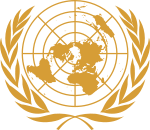Chapter XVIII of the United Nations Charter
- Chapter XVIII of the United Nations Charter
-
Chapter XVIII of the United Nations Charter deals with amendments. The process is essentially modeled after the amendment process for the United States Constitution in that:
- A two-thirds supermajority is required for adoption;
- Ratification by a supermajority of the respective states is required;
- There are two methods of proposing amendments;
- The more common of those methods is for the "first branch" (in the case of the UN, the General Assembly) to submit an amendment to the states;
- Another method, not actually used in practice, is to call a convention to propose amendments.
- The amendment procedure itself contains a provision that does not allow states (in the case of the UN, the permanent five members of the UN Security Council) to be deprived of their suffrage (in this case, their veto and/or permanent UNSC membership) without their consent. (This is analogous to the entrenched clause contained in Article Five of the United States Constitution).
There have been several amendments to the United Nations Charter since 1945, mostly to reflect increases in the size of the organization. However, the fundamental structure has remained the same. Nonetheless, the UN amendment process arguably favors the flexibility and continued existence of the organization more than the League of Nations amendment process specified by Article 26 of the Covenant of the League of Nations, which stated, "Amendments to this Covenant will take effect when ratified by the Members of the League whose representatives compose the Council and by a majority of the Members of the League whose Representatives compose the Assembly. No such amendment shall bind any Member of the League which signifies its dissent therefrom, but in that case it shall cease to be a Member of the League."
References
Categories:
- Divisions and sections of the United Nations Charter
- United Nations stubs
Wikimedia Foundation.
2010.
Look at other dictionaries:
Chapter VII of the United Nations Charter — sets out the UN Security Council s powers to maintain peace. It allows the Council to determine the existence of any threat to the peace, breach of the peace, or act of aggression and to take military and nonmilitary action to restore… … Wikipedia
Chapter I of the United Nations Charter — lays out the purposes and principles of the United Nations organization. These principles include the equality and self determination of nations and the obligation of member countries to obey the Charter, to cooperate with the UN Security Council … Wikipedia
Chapter IV of the United Nations Charter — contains the Charter s provisions dealing with the UN General Assembly, specifically its composition, functions, powers, voting, and procedures. Contents 1 Primacy of the General Assembly 2 Articles 10, 11, 12, 13, 14, 15, and 16 3 Article 17 … Wikipedia
Chapter VI of the United Nations Charter — deals with peaceful settlement of disputes. It requires countries with disputes that could lead to war to first of all try to seek solutions through peaceful methods such as negotiation, enquiry, mediation, conciliation, arbitration, judicial… … Wikipedia
Chapter II of the United Nations Charter — deals with membership of the United Nations organization. Membership is open to the original signatories and all other peace loving states which accept the obligations contained in the present Charter and, in the judgment of the Organization, are … Wikipedia
Chapter III of the United Nations Charter — summarizes the principal organs of the United Nations. They are listed in the same order as the chapters detailing their composition, functions, and powers appear in the Charter. The placement of the General Assembly first in the list probably is … Wikipedia
Chapter IX of the United Nations Charter — deals with international economic and social cooperation. Article 55 reflects the philosophy of the UN that efforts should be made to impact the root causes of war: With a view to the creation of conditions of stability and well being which are… … Wikipedia
Chapter XVI of the United Nations Charter — contains miscellaneous provisions prohibiting secret treaties, establishing the UN Charter as supreme over any other treaties, and providing for privileges and immunities of UN officials and representatives. Contents 1 Article 102 2 Article 103 3 … Wikipedia
Chapter V of the United Nations Charter — contains provisions establishing the United Nations Security Council. Article 23 establishes the composition of the Security Council, with five permanent members (the Republic of China, France, the Soviet Union, the United Kingdom, and the United … Wikipedia
Chapter VIII of the United Nations Charter — deals with regional arrangements. It authorizes regional organizations (such as NATO) and even requires attempts to resolve disputes through such agencies (if available) prior to intervention by the UN Security Council. However, Article 53… … Wikipedia

